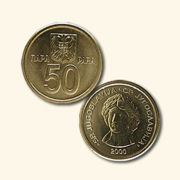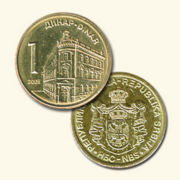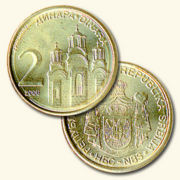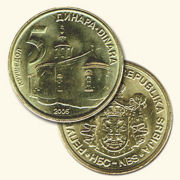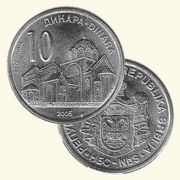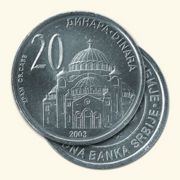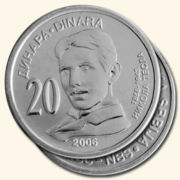塞爾維亞第納爾
出自 MBA智库百科(https://wiki.mbalib.com/)
塞爾維亞第納爾(Serbian dinars 原符號:din.;дин. 標準符號:RSD,CSD(2006年10月25日止)
目錄 |
ISO 4217 Code:RSD
User(s):Serbia (including parts of Kosovo)
Inflation:6.6%
Source:National Bank of Serbia, 2006
Subunit:1/100 para
Symbol: din. and дин.
Plura:The language(s) of this currency is of the Slavic languages. There is more than one way to construct plural forms. See article.
Coins
Freq. used :1, 2, 5, 10, 20 din.
Rarely used:50 para
Banknotes
Freq. used:10, 20, 50, 100, 200, 500, 1000 din.
Rarely used :5000 din.
Central bank:National Bank of Serbia
Website:http://www.nbs.yu
Printer:Institute for Manufacturing Banknotes and Coins - Topčider
Website:http://www.nbs.yu/export/internet/english/zin
Mint:Institute for Manufacturing Banknotes and Coins - Topčider
Website:http://www.nbs.yu/export/internet/english/zin
The dinar (plural: dinara, Serbian: динар, динара) is the currency of Serbia. An earlier currency also called dinar was the currency of the Principality, then the Kingdom, of Serbia between 1868 and 1918. The autonomous province of Kosovo and Metohia used the Deutsche Mark between 1999 and 2002, when it adopted the euro. The current Serbian dinar is a continuation of the last Yugoslav dinar.
The ISO 4217 code for the dinar is RSD (until October 25, 2006, it was CSD), the three-digit identifier is 941 (previously 891), while the local acronym is din or дин. The dinar is subdivided into 100 para (пара).
Medieval dinar
The first mention of a "Serbian dinar" dates back to the reign of Stefan the First-Crowned of the Nemanjić dynasty in 1214. Up to the fall of Despot Stefan Lazarević in 1459, most Serbian rulers minted silver dinar coins. The coin was an important symbol of Serbian statehood in the Middle Ages.
First modern dinar, 1868-1918
Following the Ottoman conquest, different foreign currencies were used up to the mid 19th century. The Ottomans operated coin mints in Novo Brdo, Kucajna and Belgrade. The subdivision of the dinar, the para, is named after the Turkish silver coins of the same name (from the Arabic bara, silver).[citation needed]
The 19th century rules of Karađorđe and Prince Mihailo Obrenović III also saw circulation of many different currencies from all over Europe, 43 different kinds: 10 gold, 28 silver and 5 copper ones.[citation needed] Following the liberation from Turkish domination, steps were taken towards the establishment of an independent monetary system.
Faced with multiple currencies in circulation, Prince Mihailo Obrenović ordered that a Serbian national currency be minted. The first bronze coins were introduced in 1868, followed by silver in 1875 and gold in 1879. The first banknotes were issued in 1876. Between 1873 and 1894, the dinar was pegged at par to the French franc. The Kingdom of Serbia also joined the Latin Monetary Union.
In 1918, the Serbian dinar was replaced at par by the Yugoslav dinar, with the Yugoslav krone also circulating until 1920.
Second modern dinar, 1941-1944
In 1941, the Yugoslav dinar was replaced, at par, by a second Serbian dinar for use in the German occupied state. The dinar was pegged to the German Reichsmark at a rate of 250 dinara = 1 Reichsmark. This dinar circulated until 1944, when the Yugoslav dinar was reintroduced by the Communist Partisans, replacing the Serbian dinar at a rate of 1 Yugoslav dinar = 20 Serbian dinara.
Third modern dinar, 2003-
The Serbian dinar replaced the Yugoslav dinar at par in 2003, when Yugoslavia was transformed into the State Union of Serbia and Montenegro. Montenegro and Kosovo had already adopted the euro.
National Bank of Serbia
The National Bank of Serbia is the central bank of the Serbia and as such its main responsibilities are the protection of price stability and maintenance of financial stability.
Core functions of the National Bank of Serbia include determining and implementation of the monetary policy, as well as that of the dinar exchange rate policy, management of the foreign currency reserves, issue of banknotes and coins, and maintenance of efficient payment and financial systems.
First modern dinar
In 1868, bronze coins were introduced in denominations of 1, 5 and 10 para. The obverses featured the portrait of Prince Mihailo Obrenović III. Silver coins were introduced in 1875, in denominations of 50 para, 1 and 2 dinara, followed by 5 dinara in 1879. The first gold coins were also issued in 1879, for 20 dinara, with 10 dinara introduced in 1882. The gold coins issued for the coronation of Milan I coronation in 1882 were popularly called milandor (French Milan d'Or (Milan of Gold)). In 1883, cupro-nickel 5, 10 and 20 para coins were introduced, followed by bronze 2 para in 1904.
Second modern dinar
In 1942, zinc coins were introduced in denominations of 50 para, 1 and 2 dinara, with 5 dinara coins following in 1943.
Third modern dinar
Coins currently in circulation are 50 para; 1, 2, 5, 10, 20 dinar coins. All coins feature identical inscriptions in both scripts the Serbian language uses, Cyrillic and Latin.
First modern dinar
In 1876, state notes were introduced in denominations of 1, 5, 10, 50 and 100 dinara. These were followed by notes of the Chartered National Bank from 1884, with notes for 10 dinara backed by silver and gold notes for 50 and 100 dinara. Gold notes for 20 dinara and silver notes for 100 dinar were introduced in 1905. During the First World War, silver notes for 50 and 5 dinar were introduced in 19143 and 1916, respectively. In 1915, stamps were authorised for circulation as currency in denominations of 5, 10, 15, 20, 25, 30 and 50 para.
Second modern dinar
In May 1941, the Serbian National Bank introduced notes for 10, 20, 50, 100, 500 and 1000 dinara. The 100 and 1000 dinara notes were overprints, whilst the 10 dinara design was taken from an earlier Yugoslav note. Further notes were introduced in 1942 and 1943 without any new denominations being introduced.
Third modern dinar
In 2003, banknotes of the Serbian National Bank were introduced in denominations of 100, 1000 and 5000 dinara. These were followed by 500 dinara in 2004, 50 dinara in 2005 and 10 and 20 dinara in 2006.
Banknotes carrying the inscription of the National Bank of Yugoslavia and its symbol ceased to be legal tender on 31 December 2006, as had been gradually replaced with new notes of the Serbian National Bank over the previous two years. Both the National Bank and commercial banks will exchange the banknotes without any fee until 31 December 2008. A further four years will be allowed for these transactions by the National Bank but they will be subject to fees.
10 Dinara Portrait of Vuk Stefanović Karadžić; members of the First Slavic Congress held in Prague in 1848 and vignette of the letters Vuk introduced. Banknote was originally released in 2000 in predominantly ochre-yellow colour with brown and green tones. It is gradually replaced with slightly lighter 2006 issue.
20 Dinara Portrait of Petar II Petrović Njegoš; 2006 edition features his figure on the back, instead of the statue from the Mausoleum on Mount Lovćen. Banknote was originally released in 2000 in predominantly green colour with ochre-yellow, and with brown and yellow tones, and it is somewhat darker than the National Bank of Serbia issue.
50 Dinara Portrait of Stevan Stojanović Mokranjac; figure of Stevan Stojanović Mokranjac, a motif of Miroslav Gospel illumination scores. Banknote was first released in 2000 in predominantly light violet colour, with magenta and yellow tones. It was slightly redesigned in 2005.
100 Dinara Portrait of Nikola Tesla; a detail from the Tesla electro-magnetic induction engine. Banknote was first released in 2000 in predominantly light and marine blue, with greenish and ochre-yellow tones. It was slightly redesigned in 2003, 2004 and 2006.
200 Dinara Portrait of Nadežda Petrović; silhouette of the Gračanica Monastery. Banknote was first released in 2001 in predominantly amber, red, and brown colours and grey-blue tones. It was slightly redesigned in 2005.
500 Dinara Portrait of Jovan Cvijić; stylized ethnic motifs. Banknote was released in 2004 with blue-green tones and in greenish and yellowish colours.
1000 Dinara Portrait of Ðorđe Vajfert, an outline of Vajfert's beer brewery, hologram image of St. George slaying a dragon; details from the interior of the main building of the National Bank of Serbia. Banknote was released in 2001 in predominantly bright red colour, with yellowish and grey-blue tones. It was slightly redesigned in 2003 and 2006.
5000 Dinara Portrait of Slobodan Jovanović and an ornamental detail from the building of the Serbian Academy of Arts and Sciences; silhouette of the National Parliament. Banknote was released in 2002 in predominantly green colour, with violet and grey-yellow tones. It was slightly redesigned in 2003.
The Serbian newspaper Danas and B92 reported in September 2006 that a set of completely renewed dinar banknotes will be issued in early 2007. The NBS did not confirm nor deny, but said instead that 'Treasury department has a lot of plans'.
